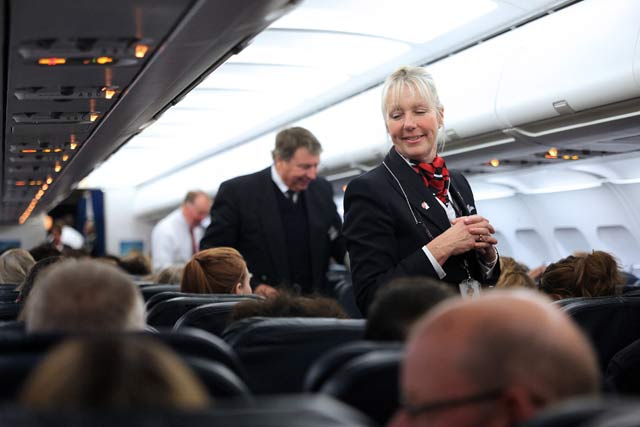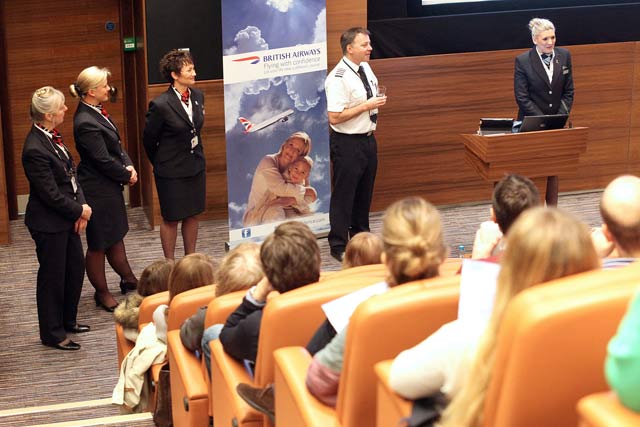For many people, flying is an experience to look forward to, thanks to the aircraft’s ability to shrink the world for the purposes of business, pleasure or adventure. And more than 60 years since the dawn of the commercial jet age, boarding a flight is statistically proven to be safer than making the journey to and from an airport by road or rail.
But despite the huge advances in technology, operating standards and safety recorded over the past several decades, for some, the prospect of leaving the ground in a jet-propelled metal tube is a terror-inducing threat that can keep them from visiting friends and family, going on holiday or advancing their careers. For would-be travellers in this category, a very real fear can represent an insurmountable barrier, and prevent them from taking advantage of one of the true wonders of the modern age.
So, how can those with an overwhelming dread of flying be helped to address their fears?
For the past 30 years, British Airways has sought to do just this, through a regular series of courses staged at locations in the UK and overseas open to people wanting to beat their phobia and take to the skies. Named “Flying with Confidence”, the initiative is run at London’s Heathrow and Gatwick airports, and additional sites including Dublin, Edinburgh and Manchester, plus Dubai and Johannesburg.
FlightGlobal was invited to attend one such course at Gatwick late last year, where a group of more than 80 delegates met a dozen BA staff – including senior pilots and cabin crew – who volunteer their time to run the course.
The carrier divides its standard one-day session into two parts: an explanation of how an aircraft and its systems work, along with associated elements such as air traffic control; and an exploration of the psychological aspects that hold back those wishing to beat their fears. These are followed by a short flight experience in one of BA’s jets – lasting around 45min – to put the theory into practice.

A team of volunteers from the airline help to ease any nerves during end-of-course flight
British Airways
Rationalisation
By looking at available statistics – which show that there are around 110,000 scheduled commercial flights every day – the rational mind can calculate the incredibly small likelihood of being involved in an airliner accident. FlightGlobal’s figures for 2016 show that there were 11 fatal mishaps resulting in a combined 239 deaths, excluding deliberate acts such as terrorism. A record-breaking 2015 saw these figures achieve a historic low of nine accidents and 176 fatalities, respectively. And as the industry drives further towards an accident-free utopia – which in reality may never be realised as flight numbers increase – it is also focusing on improvements in security and crew selection/screening.
For a nervous flyer, however, no amount of numbers can remove the fear that something might happen to them, regardless of the percentage chances. While many who are feeling such unease may get themselves through the flight experience somehow – perhaps by resorting to medication or alcohol – BA notes that one in four people have a fear of flying.
Capt Gordon Black – a Boeing 777 training captain with around 40 years’ experience with the flag-carrier, says obstacles in the way of reluctant travellers can be built up as a result of a lack of knowledge, control or familiarity with aviation, or even over familiarity. Perceived knowledge about the risks associated with flying can be misplaced, influenced by partial media reporting of the rare number of fatal accidents, or simply grounded in myth, he suggests.
The course leader for the recent Gatwick event, Capt Andy Shaw, delivered the technical part of the presentation, which ranged from covering the fundamentals of flight and aerodynamics to wing design and strength, fuel reserves and diversion practices. A 787 captain with experience totalling more than 20,000 flight hours and over 20 years at BA, he also explained why a jet engine makes more noise during some phases of a flight, and how aircraft can continue to fly safely in the event of a failure.
“Many people don’t like take-off, but they do like landing,” Shaw says, pointing to one of the phases of flight that causes the greatest anxiety to many. Leaving the ground is optional, but returning is obligatory, he notes.
Lack of control is a major contributor to anxiety around flying, as is the case for individuals who perhaps do not like to be driven by someone else when in a car. One of the recent Gatwick course attendees was the holder of a current private pilot’s licence, but was nervous about flying with an airline for those very reasons.
Another attendee – who was planning a trip to New Zealand – had previously opted against taking a flight from London to Edinburgh because of his anxiety, instead opting to take a much longer and more expensive journey to the Scottish capital by train.
The technical part of the course also explains what causes turbulence – described by Black as “everyone’s favourite” phobia – and how different people perceive it. Many pilots with decades of experience in the cockpit have never encountered the severe turbulence that many anxious flyers feel to have endured in the past, and the course suggests that alarming media reports of aircraft “plunging thousands of feet” during such incidents are often inaccurate, and heighten ill-placed fears.
In a book produced to accompany the training programme, Flying with Confidence course director Capt Steve Allright notes: “Flightcrew around the world share a common classification of turbulence: light, moderate and severe. For the fearful flyer, even light turbulence can be upsetting [while] for pilots it is no different to a bumpy road: a small, but totally safe inconvenience and very much part of our daily lives.”
This section of the course also affords the chance for nervous passengers to ask questions of an airline captain: an opportunity they might never get otherwise.
Questions on the day included those about turbulence, communicating with passengers – or not – when something goes wrong, executing go-arounds and pilots consuming alcohol, with Shaw explaining each in turn.
Speaking separately, Allright – who has been involved with the programme for 24 years and co-authored the BA-produced book with psychologist Patricia Furness-Smith – notes: “If your question starts with ‘what if’, we’ve practised it in the simulator.”
He lists simulator-based “what-ifs” as including “Just about anything and everything you could possibly imagine. Engine failures, gear failure, flap failure, loss of electrics, hydraulics, volcanic ash encounter, decompression, fire, medical emergencies, pilot incapacitation, diversion.”

Capt Steve Allright and his colleagues answer questions during a recent Heathrow course
British Airways
Rigorous testing
Already among the most highly-trained professionals among any career, commercial airline pilots undergo regular refresher courses and testing in the synthetic arena. For BA pilots, this means two 4h simulator details every six months including testing, plus an annual medical check. They also fly as part of a team, notes Black, increasing overall safety.
Flight Fleets Analyzer records BA as having an in-service fleet of 269 jets, comprising Airbus A320-family narrowbodies, A380s, Boeing 747s, 767s, 777s and 787s. Its current network serves 196 destinations in 85 countries, according to FlightMaps Analytics. It carries more than 40 million passengers a year, with around 650 flights per day.
Also delivering the flight element of the course in Gatwick was Capt Alistair Black, who would be one of the pilots to fly delegates on an A319 at the end of the day and put their learning into action. His task was to explain the “protective bubble” that safeguards an aircraft in flight, detailing its horizontal and vertical minimum separation distances and also explaining the liaison between pilots and air traffic controllers, plus the workings of modern terrain and collision avoidance system technology. He also noted how this protective space is increased in size in areas without radar coverage.
Psychological aspects of a fear of flying were covered by Furness-Smith: a former 747 stewardess who had her own such encounter during a long-haul flight while still working for an airline.
For Furness-Smith, phrases like “fight and flight” and “territorial imperative” are key to explaining the anxieties that travellers may experience. Leaving the ground is not a natural event for humans, she notes, and it is easy for a fear of something unknown to overtake rational thought. “If you’ve perceived it as a threat, then that’s enough,” she says.
Because of its combination of factors including height and an enclosed space, Furness-Smith describes “aviophobia” as “the Rolls-Royce of phobias”. Sufferers can be those who have never flown before, experienced a previous trauma, or even those who “have devoured other people’s experiences and become vicariously traumatised”, she says.
Important elements of the pre-flight preparations include relaxation and breathing techniques, to avoid or control what she refers to as “anticipatory anxiety” which can become part of an individual’s “behavioural DNA”. “Fear is harmless – it is when it is operationalised that it becomes nasty,” she adds.
An aversion to flight cannot be overcome unless someone wants to address the issue, but is less debilitating a problem than for an individual with a fear of people, which cannot be so easily avoided during day-to-day life, she notes.
According to the book accompanying the course, “the key to overcoming your fear is to be proactive, have self-belief, instil a positive attitude, and apply your knowledge and tools”.
At the end of the classroom phase, attendees passed through airport security to board the aircraft that would test their new-found determination. Once onboard the A319, Shaw provided a running commentary from the flightdeck, so that passengers were not left to wonder what that sound was – from the narrowbody’s auxiliary power unit switching off and the lights blinking during engine start-up, to the type’s distinctive “barking dog” sound after landing.
Of those who attended, only a couple opted against taking the brief experience flight at the end of the course, which was just long enough to allow passengers the chance to get out of their seats and move around the cabin – for some, only after they released their tight grips on the armrests for the first time.
The experience at the recent Gatwick event underscored the proven success of the Flying with Confidence scheme: BA says that more than 50,000 people have now attended, and it cites a success rate of 98%. While by no means everyone attending the day will relish the prospect of flying in the future, many will at least be able to do so without encountering the stress of the past.
Just shy of 1,300 people attended BA’s courses in 2016, and for the airline’s volunteers, it is a great opportunity to make a difference. While as every pre-flight announcement highlights, the cabin crew are there primarily to ensure comfort and the safety of their passengers, getting the chance to work with a group of nervous flyers brings immediate rewards.
For one attendee speaking after the Gatwick course – who had not flown for some time after encountering turbulence on an earlier trip – this was exactly the case. “I’m off to book a holiday,” she said.
The scheme delivered its first course of 2017 on 4 February, welcoming 130 people at Heathrow. Now in its fourth decade of helping passengers to overcome their fears, BA looks forward to welcoming many more aboard this year and beyond.
Source: Flight International


























